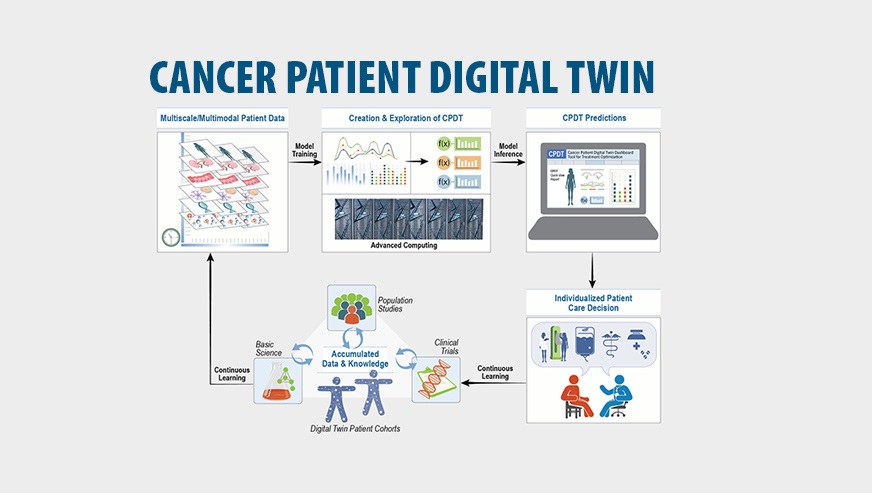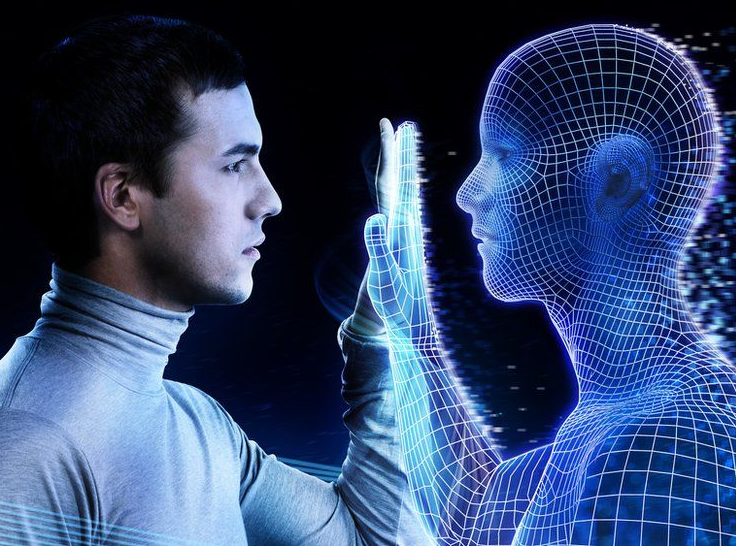How Digital Twin can remodel future Cancer Care?
Introduction
In the array of ever-growing technologies, ‘Digital Twins’ have accelerated in the last few years. The idea of the Digital Twins’ is not new. This idea was defined in the early 2000s and from then on, Digital Twin tech has evolved to a point where various fields are trying to adapt to this new trend. With IoT (Internet of things), the computing power of cloud-based systems, and the widespread use of 5G networks, the adoption is becoming easier comparatively.

A proposed framework for Cancer Patient Digital Twins (CPDTs) — virtual representations of cancer patients using real-time data — would combine high-performance computing modeling and simulation, model inference, and clinical data to make treatment predictions and individualized health care decisions for cancer patients. Illustration by Jeannette Yusko and Janelle Cataldo/LLNL. Source of information
‘Digital Twins’, if you are unfamiliar with this phrase, can be simplified with an illustration. You have a duplicate digital portrayal of your house that you are planning to renovate. Now you can enter your choices in the digital system and look at the outcome of how your house is going to look. You can take time to decide before making those choices in real life. You have not even moved a single piece of furniture yet, but still know how the redo is supposed to look. It helps you plan better and estimate the cost of a makeover. The same principles apply to the Digital Twin. It revolves, however, around the type of domain in which you want to apply this idea.
In the case of cancer care, it is about replicating the functioning of a human body by feeding the live data right from the molecular level to daily lifestyle into Digital Twin. Unlike real-life biological twins, the digital twin is a perfect clone from every heart pulse to sensory sparks in the body. Digital twins, just like cancer treatment, are unique to the biology of that patient. As a result predictions about the possible future health condition and treatment can be made with precision. For instance, the type of drugs or combination of drugs for the treatment of complex diseases like cancer.
Recent studies have shown that Digital Twin technology can help reshape oncology predictions for conservative cancer care for patients where cancer cells have an aggressive rate of multiplying and mutating. A multi-institutional team, including the Lawrence Livermore National Laboratory (LLNL) contributor, has proposed a framework for Digital Twin models of cancer patients called ‘CPDT’ that researchers say would create a “paradigm shift” for predictive oncology.
Incorporation

Source: https://tectales.com/bio-tech-it/digital-twins-for-more-personalized-medicine.html
It would be tedious for a cancer patient to adopt this method. They can have a Digital Twin who will live their life digitally on the ground of incorporating real data from them such as scans, various reports, types of medicines, and their lifestyle. A high-performance computing model will perform the process of prognosis using machine learning and AI to find out the future growth of cancer cells in the body and the most suitable treatment that can help to improve patients’ health conditions. The prognosis by Digital Twins would be compared to real-life measurements which will then help gauge the performance of the Digital Twin too.
This route of treatment would reduce some burden off the patients’ shoulders. Perhaps, they may not buy this idea at first. Well, I wouldn’t blame them for this. It will take time for people to understand this futuristic mode of treatment.
According to the paper published in the year 2021, the proposed Cancer Patient Digital Twin(CPDT) should be fed with the data which is obtained from populations of various diversity and ethnicity so that the advantage of CPDT can be achieved by a wider range of populations worldwide.
The Digital Twin is, after all, a digitally developing child that is learning new things based on what we give them. Therefore, it is prone to get influenced by biased data. Stringent rules and appropriate standards need to be imposed to avoid any partiality. This kind of model should be continuously tested.
CPDT must be methodically fused into the current medical workflow so that it permits the doctor and the patients to make better decisions.
Challenges
No doubt! This kind of treatment is an uphill climb. There are various challenges on the path to seamlessly putting this brand-new development into the world of the healthcare system. Let us look at a few of them:
Data
- The data which is a staple for Digital Twins must be obtained from a diverse population.
- High volume and high quality are the keys to an accurate result.
- Data collected from patients at different stages is important.
Design and Integration
- Systematic synchronization of old and new data.
- The state of disease needs to be accurately characterized using multimodal data fusion methods.
- Seamless integration of data-driven standards and theoretical predictions.
- Mitigating uncertain behaviors via training and justification.
- Access to patient data for a smooth workflow and high-performance computing across the system is required.
Moral challenges
- Ethical biases and privacy concerns by patients are the prime concern.
- Keep a check on the voices of stakeholders in CPDT development.
- Standards and rules need to be followed throughout the development of CPDT.
- Regulatory standards for data handling and usage should be put in place.
References:
- Digital twins for predictive oncology will be a paradigm shift for precision cancer care. “Nature Medicine | VOL 27 | December 2021.” Retrieved from: https://www.nature.com/articles/s41591-021-01558-5.epdf?sharing_token=eJXiqRjfwFndFlL8Qnw83tRgN0jAjWel9jnR3ZoTv0OiERwZDZ-m1NWnE9l1iwBnoN137HSMCeFbXnmpJ7a7zhKavlefldNtH19oW4POMSBu6dm3uMWrnyCk3XV_mfjIhzUBSEeMerQYIYa0eTdzqqrQtUM6UI4Hj6Onqxkir24%3D
2. Digital twins for cancer patients could be a ‘paradigm shift’ for predictive oncology. Dec 16, 2021. Retrieved from: https://www.llnl.gov/news/digital-twins-cancer-patients-could-be-paradigm-shift-predictive-oncology-0
3. Tectales Technologies. (BIO)TECH & IT. March 22, 2021. ”Digital twins for more personalized medicine”. Retrieved from: https://tectales.com/bio-tech-it/digital-twins-for-more-personalized-medicine.html
4. Miller. A. May 23rd, 2022. Technology Networks.Cancer Research.“ Using Cancer Patient Digital Twins to Transform Cancer Care. Retrieved from: https://www.technologynetworks.com/cancer-research/articles/using-cancer-patient-digital-twins-to-transform-cancer-care-361478
5. Mamula. K, June 8th, 2022. Medical Express. “Seeing double: Using virtual twins to help personalize medicine”. Retrieved from: https://medicalxpress.com/news/2022-06-virtual-twins-personalize-medicine.html






